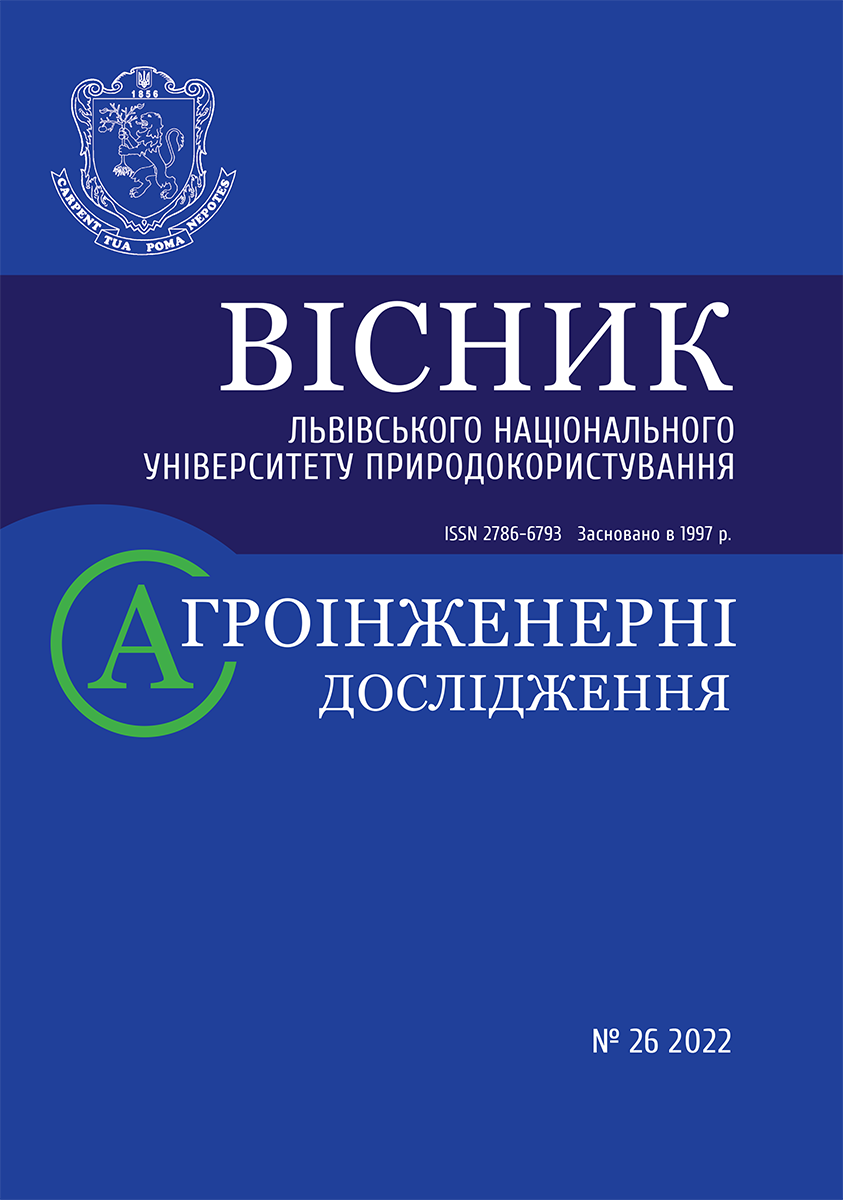Rationale for using a car fuel tank air filter
DOI:
https://doi.org/10.31734/agroengineering2022.26.140Keywords:
air purification filter, fuel tank, hydrophobic partition, filter partition regenerationAbstract
The importance of diesel fuel purification from mechanical pollution and water in fuel supply systems of cars diesel engines used in the conditions of agricultural production is substantiated. It is established that various methods are used to remove contaminants, which are caused by chemical, physical-chemical and physical processes. Physical methods are most often used to clean and dehydrate fuel, using filter porous partitions. The advantages and disadvantages of hydrophilic and hydrophobic filter materials are established. The emphasis is placed on the prospects of using hydrophobic materials with ensuring their continuous or periodic regeneration. One way to reduce fuel pollution in diesel engine supply systems is to prevent them from entering the fuel tank. Different ways of solving this problem are analyzed. Contamination enters the tank during fuel consumption, during refueling, as well as during small breaths of tanks from the atmosphere. The location of fuel tanks is justified for technological reasons of fuel supply, but in terms of air pollution, they are located in the zone of greatest dust. The theoretical analysis of the mechanical impurities accumulation processes in the cars tanks, taking into account operational and design factors showed that minimization of fuel pollution in the cars tanks can be achieved by using devices that prevent contaminants in fuel tanks. It is established that the use of a technical device to prevent contaminants from entering the fuel tank with an efficiency of 0.65 is equivalent to the use of a fine fuel filter with a nominal 95% fineness of cleaning d0.95 = 2.9 μm. Such device may be the filter for cleaning the air entering the fuel tank with using a hydrophobic filter partition, the regeneration of which occurs from the vibrational vibrations of the internal combustion engine. The filter is fixed on the fuel tank by means of the spring, the stiffness of which is chosen from the resonance condition. The cleaning system, which includes both tank protection and filtration, will allow to obtain high quality cleaning and efficiency of the cleaning system itself, which is determined by the filtration costs, which in turn depend on the resource of changing filter elements and the amount of contaminants circulating in the fuel system.
References
Bannyi, O. O., & Mateiko, R. O. (2020). Suchasni palyvni filtry tiazhkoi tekhniky. In Nadiinist silskohospodarskoi tekhniky v systemi innovatsiinykh protsesiv: Materialy V nauk.-prakt. seminaru (s. 40-43). Kyiv.
Bejger, A., & Gawdzinska, K. (2016). Fuel system contamination affecting injection equipment of diesel engines. Applied Mechanics and Materials, 817, 27-33. doi: 10.4028/www.scientific.net/AMM.817.27.
Bila, Ya. Yu., Yaremchuk, T. O., & Titova, L. L. (2019). Pidvyshchennia resursu palyvnykh filtriv i pokrashchennia yakosti ochystky palyva. In Suchasni tekhnolohii ahrarnoho vyrobnytstva: Materialy V Mizhnar. nauk.-prakt. konf. (s. 34-35). Kyiv.
Bozhok, A. M., Lisoval, A. A., & Rykova, I. V. (2012). Zapobihannia vyparovuvannia palyva z baka transportnoho zasobu. Visnyk Natsionalnoho transportnoho universytetu, 25, 86-89.
Kaliuzhnyi, O. B., & Platkov, V. Ya. (2021). Pidvyshchennia resursu roboty filtriv ochyshchennia biopalyv. In Novi i netradytsiini tekhnolohii v resurso- i enerhozberezhenni: Materialy Mizhnar. nauk.-tekhn. konf. (s. 53-56). Odesa: DU «Odeska politekhnika».
Lisieieva, A. I. (2020). Sutnist roboty palyvnykh filtriv dlia dyzelnykh dvyhuniv. In Innovatsiine zabezpechennia vyrobnytstva orhanichnoi produktsii v APK: Materialy V Mizhnar. nauk. konf. v ramkakh roboty XXXII Mizhnar. ahropromyslovoi vystavky «AHRO 2020» (s. 128-129). Kyiv.
Marchak, T. V., Romanov, O. M., & Chernyshuk, V. V. (2011). Ohliad konstruktsii filtriv dlia znevodnennia biopalyv v systemakh zhyvlennia avtotraktornykh dvyhuniv. Zbirnyk naukovykh prats Vinnytskoho natsionalnoho ahrarnoho universytetu, 9, 194-201.
Mironyuk, O. (2021). Assessment of the noise level on arterial streets depending on traffic flow indicators. Transport Technologies, 2(2), 52-63. doi: 10.23939/tt2021.02.052.
Myroniuk, O., Shevchuk, V., & Paslavskyi, R. (2021). Doslidzhennia dvostupinchatoho filtra ochystky dyzelnoho palnoho. Visnyk Lvivskoho natsionalnoho ahrarnoho universytetu: Ahroinzhenerni doslidzhennia, 25, 49-56.
Myroniuk, O. S., & Kovalchuk, I. M. (2021). Filtr ochystky dyzelnoho palyva u tsyrkuliatsiinykh systemakh palyvopodachi. In Vseukrainska naukova konferentsiia molodykh uchenykh i naukovo-pedahohichnykh pratsivnykiv: Materialy (s. 175-176). Uman: VPTs «Vizavi».
Nazarenko, I. P., Koval, D. M., & Dubinina, S. V. (2015). Metody i tekhnichni zasoby ochyshchennia naftoproduktiv. Naukovyi visnyk Tavriiskoho derzhavnoho ahrotekhnolohichnoho universytetu, 2(5), 231-234.
Novytskyi, A. V., Karabynosh, S. S., Ruzhylo, Z. V., & Novytskyi, Yu. A. (2018). Use pro palyvni filtry dvyhuniv. Agroexpert, 3, 88-92.
Prodeus, O. V., Novytskyi, A. V., & Ruzhylo, Z. V. (2017). Liderstvo v sferi filtratsii – efektyvnyi napriam zabezpechennia nadiinosti tekhniky. In Problemy konstruiuvannia, vyrobnytstva ta ekspluatatsii silskohospodarskoi tekhniky: Materialy XI Mizhnar. nauk.-prakt. konf. (s. 255-256). Kropyvnytskyi.
Rilo, I. P., Marchuk, M. M., & Kolesnyk, O. A. (2012). Vykorystannia ekspluatatsiinykh materialiv ta ekonomiia palyvno-enerhetychnykh resursiv. Rivne: NUVHP.
Udler, E., Isaenko, V., Isaenko, P., Isaenko, A., & Zykov, S. (2015). To assess the performance of the new fuel filter elements. Harvard Journal of Fundamental and Applied Studies, 8, 586-593.
Yatsun, V. I., & Titova, L. L. (2019). Palyvopodaiuchi systemy avtomobilnykh dyzeliv. In Suchasni tekhnolohii ahrarnoho vyrobnytstva: Materialy V Mizhnar. nauk.-prakt. konf. (s. 32-33). Kyiv.


